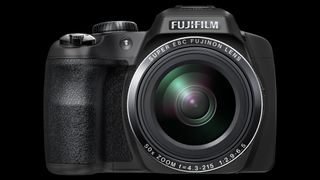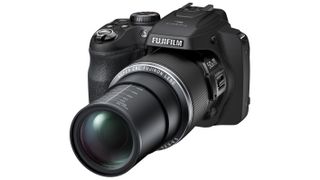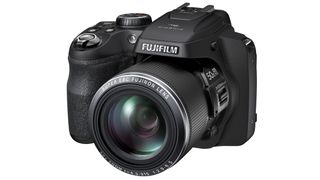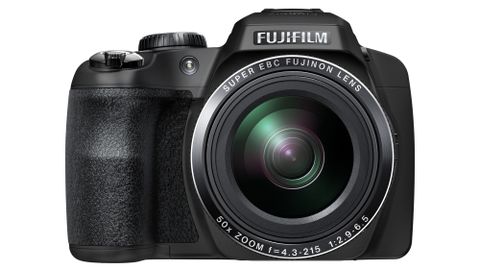Why you can trust TechRadar
The 50x optical zoom range was the first thing we wanted to test, and the focal reach of the Fuji SL1000 offers a staggering number of picture possibilities. This type of reach takes street photography to an entirely new level.
Of course, there is a catch to shooting at such a long focal length. The slightest hand movement vastly alters a composition, subjects can be difficult to find again once zooming in and they can be very shaky within the frame once you do, making composition difficult. To get sharp, well-composed images at this focal length you really need to support the camera and keep still. But this isn't entirely unexpected.

If the 50x zoom isn't enough for you, the Fuji SL1000 offers two macro modes: a Super Macro mode enables you to focus as close as 1cm (though without zoom capability), while the standard macro mode enables you to focus at 7cm at the wide end of the focal range, and 3.5m at the telephoto end.
Image-wise, the Fuji SL1000 doesn't miss a beat. Colours are clear and natural-looking using the camera's standard colour mode, if ever so slightly on the cool side, and the sensor does a nice job of resolving detail in scenes with strong light, and even in scenes that lack contrast. Images from the Fuji SL1000 appear natural-looking across a range of light conditions.
On the whole, when reviewing our pictures from this camera on the computer there were few, if any, edits required to bring out the colours in our subjects. Only in a few instances under mixed lighting did skin tones require a slight Levels adjustment to tone down the yellow.
The Fuji SL1000 is also quite capable of capturing detail across a range of tones, even in strong light. Taking advantage of a string of nice days, we framed some landmarks against the bright blue sky and were able to capture the rich blue of the sunny day, while registering detail in the brick work of the buildings' facades.
Images are crisp and clear at the lower end of the ISO range, as you would expect. However, smudging and softening of detail starts to become noticeable from ISO 400 - which was a little too low on the scale for our liking, considering that ISO 400 is often a default setting for many people shooting at weddings and other indoor events.
This can probably be attributed to the Fuji SL1000's smaller sensor. That said, smudging at this level was evident only when viewed at actual pixels, and again at just below 100%, so for the average person taking pictures at a wedding reception, this won't be a problem.

Noise is generally well contained in images from the Fuji SL1000. Shooting indoors we could comfortably push the sensitivity up to the higher reaches of the scale and come away with usable images. ISO 1250 appears to be the threshold at which the first hints of noise show up.
Thankfully, it doesn't get too much worse, as the Fuji SL1000 adjusts to a smaller pixel count at its top settings of ISO 6400 and 12,800. But this comes at the expense of image clarity and definition.
While chromatic aberrations are present at the telephoto end of the FinePix SL1000's focal range - particularly at the edges of the frame - distortion is largely kept under control.
We found the Fuji SL1000's autofocus system was as fast as advertised (0.2 secs), and very rarely did it pick out the wrong target. In every instance, even in dull lighting, we were able to pick out the key elements within the frame and keep them sharp - although images appear a little less sharp when shot from a distance at the telephoto end of the zoom. But they're well within reason.

The Fuji SL1000's HDR mode does a great job at extending the camera's dynamic range and enabling you to capture more detail, particularly in shadow areas.
However, we found its slow processing time meant having to hold the camera perfectly still. In fact, the camera warns you to keep it still and maintain the framed composition. It's really a job for shooting with the camera on a tripod. On several occasions we found HDR images that looked like 3D images, as the elements didn't quite match in the three exposures. With clouds or people, this should be expected. But not with stationary objects.
There are a number of other creative modes on the Fuji SL1000, designed to help you capture more detail. For instance, a writing mode for shooting signs detects writing within your frame and gives images more contrast to make the letters crisp and identifiable. However, the difference is fairly slight, in our opinion.
The Fuji SL1000 offers a range of creative art filters to apply to your images, most of which are standard fare on cameras of this type. However, the Fuji SL1000 renders a nice effect, even if some of them - namely the new Cross Screen effect, which creates starbursts around bright objects - are a little cheesy. Others such as the High Key and Toy Camera effects are quite nice, offering a subtle rendition.
Video

The Fuji FinePix SL1000 is a great tool for budding videographers. The sensibly placed one-touch video record button on the back of the camera - at the top-right of the LCD screen - is easy to use, and video quality is crystal clear when recorded in Full HD at 60fps
You can also record at 1280 x 720 (60fps), 640 x 480 (120fps) and high speed modes (320 x 240 at 240fps), which enable you to produce slow-motion videos.
Fuji has given photographers use of the optical zoom when shooting videos (we found this is where the zoom toggle on the lens barrel really comes into its own), which is a nice touch. However, be warned that noise from the zoom motor is evident when playing back your videos, although it's not too bad. What's more, you can film using the camera's colour modes, such as sepia or black & white.
Finally, there are a number of great in-camera features to use post-capture, such as Movie Trimming, which enable you to prime your videos for YouTube or however you plan to use them.

Meta’s massive OS announcement is more exciting than a Meta Quest 4 reveal, and VR will never be the same again

World's fastest broadband connection went live down under — Nokia demos 100 gigabit internet line in Australia in record-breaking attempt but doesn't say when it will go on sale

Don't miss the Samsung Galaxy S23 Ultra for just $849 at Best Buy right now
